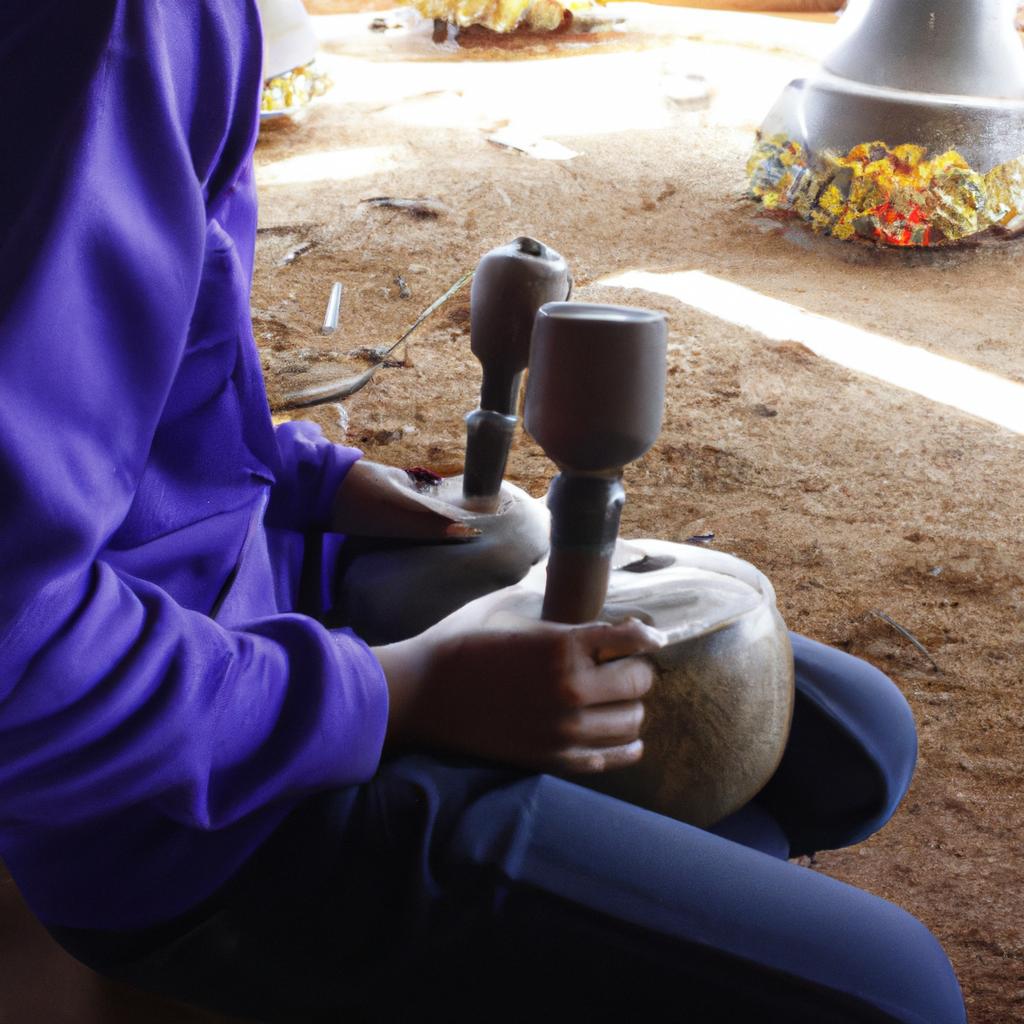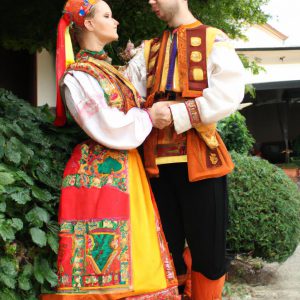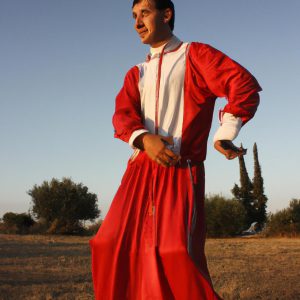Songs in the Context of Ashkenazi Heritage: Traditions

Songs play a significant role in preserving and conveying the rich cultural heritage of the Ashkenazi Jewish community. Passed down from generation to generation, these songs serve as powerful vessels that encapsulate the traditions, values, and experiences of this distinct group. To illustrate this point, let us consider a hypothetical scenario where an individual discovers an old handwritten songbook hidden away in their family’s attic. As they delve into its pages, they are transported back in time, connecting with their roots and gaining insight into the customs and beliefs that shaped their ancestors’ lives.
The Ashkenazi tradition encompasses a diverse range of musical styles and themes. From joyful wedding tunes to solemn liturgical chants, these songs reflect the multifaceted nature of Ashkenazi culture. Furthermore, within each song lies a wealth of historical narratives waiting to be explored. For instance, one might come across lullabies sung by mothers to soothe their children during times of persecution or resistance anthems composed during periods of social upheaval. By examining these melodies alongside historical records and oral testimonies, scholars can gain deeper insights into the lived experiences and collective memory of Ashkenazi communities throughout history.
In addition to serving as vehicles for cultural preservation and historical documentation, traditional Ashkenazi songs also serve as a means of spiritual expression and emotional connection. Many of these songs are deeply rooted in religious practices and rituals, providing a channel for individuals to connect with their faith and engage in communal worship. From the melodic chants of synagogue services to the heartfelt melodies of Sabbath table songs, these musical expressions create an atmosphere of reverence, unity, and devotion.
Moreover, traditional Ashkenazi songs often convey universal themes of love, longing, joy, and sorrow that resonate with people across different cultures and backgrounds. The power of music lies in its ability to transcend language barriers and touch the hearts of listeners on a profound level. Through the melodies and lyrics of these songs, individuals can find solace in times of grief, celebrate moments of happiness, or simply experience a deep sense of nostalgia for a bygone era.
In contemporary times, efforts have been made to not only preserve these traditional Ashkenazi songs but also adapt them to modern contexts. Artists and musicians have taken inspiration from these age-old melodies and infused them with new arrangements or added contemporary elements. This fusion allows for the continuation of this rich cultural heritage while also making it accessible and relevant to younger generations.
All in all, traditional Ashkenazi songs play a vital role in preserving cultural heritage, documenting history, fostering spiritual connections, and evoking powerful emotions. They serve as timeless reminders of the resilience, traditions, values, and experiences that have shaped the Ashkenazi Jewish community throughout its history.
Historical Background of Ashkenazi Music
To understand the rich and diverse traditions of Ashkenazi music, it is essential to explore its historical background. One compelling example that illustrates the significance of this heritage is the case study of Eastern European Jewish communities during the late 19th century. These communities were marked by a vibrant musical culture that played a central role in their religious, social, and cultural lives.
The development of Ashkenazi music can be attributed to several key factors. Firstly, the migration patterns of Jews across Europe resulted in encounters with various local musical traditions. As they settled in different regions, Jews infused elements from these surrounding cultures into their own music, creating a unique blend of influences. This process led to the formation of distinct regional styles within Ashkenazi music.
Furthermore, religious practices significantly shaped the evolution of Ashkenazi musical traditions. Synagogue liturgy played a crucial role in fostering both vocal and instrumental forms of expression. Cantillation, or chanting biblical texts using specific melodic motifs known as “nusach,” became an integral part of communal worship. Additionally, klezmorim (professional musicians) provided entertainment at weddings and other festive occasions, contributing to the flourishing secular aspect of Ashkenazi music.
- The haunting melodies used in Ashkenazi funeral dirges reflect centuries-old mourning rituals.
- Joyous wedding tunes filled with spirited dance rhythms celebrate life’s milestones.
- Lamentations sung on Tisha B’Av commemorate historic tragedies such as the destructions of Jerusalem temples.
- Hymns composed for Sabbath services create an atmosphere conducive to spiritual contemplation.
In addition to textual descriptions and bullet points, we can also incorporate a table that showcases different types of traditional songs found within Ashkenazi music:
| Song Type | Purpose | Emotional Tone |
|---|---|---|
| Nigunim | Mystical meditation | Contemplative |
| Freylekhs | Wedding celebrations | Exuberant |
| Zog Nit Keynmol | Holocaust memorial | Solemn |
| Shabbat zemirot | Sabbath worship | Reverent |
In conclusion, the historical background of Ashkenazi music reveals a rich tapestry of cultural influences and religious practices. The migration patterns of Jewish communities across Europe, encounters with diverse musical traditions, and the intertwining of sacred and secular elements have all contributed to the development of this unique musical heritage. Understanding these origins provides valuable insights into how Ashkenazi music has evolved and continues to be cherished today.
Transitioning seamlessly to the subsequent section on “Influences on Ashkenazi Musical Traditions,” we can explore further factors that have shaped and molded this captivating genre.
Influences on Ashkenazi Musical Traditions
Transitioning from the historical background of Ashkenazi music, it is important to explore the cultural significance that this musical tradition holds. One example that exemplifies this significance is the use of traditional Jewish folk songs during celebrations and rituals within Ashkenazi communities. These songs not only serve as a form of entertainment but also play a vital role in preserving and transmitting cultural values across generations.
To understand the emotional impact of Ashkenazi music, several key aspects come into play:
-
Connection with Ancestral Heritage:
- The melodies and lyrics of these songs reflect centuries-old traditions.
- They evoke a sense of nostalgia and foster a connection between present-day individuals and their ancestral roots.
- This deep link to heritage fosters feelings of belonging and pride within Ashkenazi communities.
-
Communal Identity:
- Ashkenazi music has long been ingrained in communal gatherings such as weddings, bar mitzvahs, or holiday celebrations.
- The collective singing and participation create an atmosphere of unity and solidarity among community members.
- Through shared experiences, these songs strengthen bonds among individuals who share a common cultural identity.
-
Emotional Expression:
- Many Ashkenazi folk songs convey emotions ranging from joy to sorrow.
- Through melodic nuances and poetic lyrics, they provide an outlet for emotional expression.
- This allows individuals to connect with their own personal experiences while simultaneously connecting with others through shared sentiments.
-
Continuity in Tradition:
- By performing these songs, younger generations maintain a direct link to their ancestors’ customs.
- Transmitting these traditions ensures their preservation amidst evolving societal changes.
- It serves as a testament to the resilience and adaptability of the Ashkenazi culture throughout history.
Table: Examples of Emotionally Significant Ashkenazi Folk Songs
| Song Title | Emotion Conveyed | Context of Use |
|---|---|---|
| “Oifn Pripetchik” | Nostalgia | Teaching children about values |
| “Tumbalalaika” | Joy, Love | Celebratory events |
| “Roshinkes mit Mandlen” | Comfort, Serenity | Lullabies for infants |
| “Yiddishe Mama” | Longing, Remembrance | Tribute to maternal figures |
In conclusion, Ashkenazi music holds immense cultural significance within Jewish communities. Through its connection with ancestral heritage, the fostering of communal identity, emotional expression, and continuity in tradition, it serves as a powerful medium that resonates deeply with individuals. Understanding these aspects is essential to exploring the characteristics of Ashkenazi folk songs.
As we delve into the characteristics of Ashkenazi folk songs, an examination of their unique qualities unveils a rich tapestry of musical expressions deeply rooted in this vibrant cultural heritage.
Characteristics of Ashkenazi Folk Songs
Having explored the diverse influences that have shaped Ashkenazi musical traditions, it is essential to delve into the characteristics of Ashkenazi folk songs. By examining these characteristics, we can gain a deeper understanding of how music plays an integral role in preserving and expressing this rich cultural heritage.
To better grasp the essence of Ashkenazi folk songs, let us consider an example. Imagine a group of Jewish families gathered for a festive occasion, their voices blending harmoniously as they sing traditional melodies passed down through generations. These songs are deeply rooted in history and reflect various aspects of the Ashkenazi experience.
Ashkenazi folk songs exhibit several distinct features that set them apart from other musical genres:
- Melancholic Tunes: Many Ashkenazi folk songs evoke a sense of longing and melancholy, reflecting historical experiences characterized by persecution and exile.
- Liturgical Influence: Drawing inspiration from religious texts and prayers, these songs often contain elements borrowed from liturgical music.
- Yiddish Language: Most Ashkenazi folk songs are sung in Yiddish, which was the primary language spoken by Eastern European Jews.
- Narrative Storytelling: The lyrics frequently tell stories of love, loss, hope, or historical events, serving as reminders of shared experiences within the community.
In order to provide a visual representation of some notable examples within this genre, consider the following table showcasing four well-known Ashkenazi folk songs:
| Song | Meaning | Theme |
|---|---|---|
| “Oyfn Pripetchik” | On The Hearth | Childhood Education |
| “Tumbalalaika” | Little Balalaika | Love and Courtship |
| “Shalom Aleichem” | Peace Be Upon You | Sabbath Welcoming |
| “Zog Nit Keynmol” | Never Say | Resistance and Hope |
These examples highlight the emotional range and thematic diversity found within Ashkenazi folk songs. Each song carries a unique message, resonating with different aspects of Jewish life.
In light of these characteristics, it becomes evident that music holds a significant place in preserving the cultural heritage of Ashkenazi Jews. Through their powerful melodies and poignant lyrics, these songs have served as vessels for expressing collective memories, emotions, and aspirations.
Understanding the role of music in Ashkenazi religious life allows us to appreciate how this art form intertwines with sacred rituals and communal worship. By exploring this aspect further, we gain insight into the profound impact of music on spiritual experiences within the Ashkenazi tradition.
Role of Music in Ashkenazi Religious Life
Transitioning from the previous section on the characteristics of Ashkenazi folk songs, it is important to understand how these songs fit into the broader context of Ashkenazi heritage. By examining their role within religious life and cultural traditions, we can gain a deeper appreciation for the significance they hold.
To illustrate this point, let us consider a hypothetical scenario. Imagine a young Jewish individual growing up in a tight-knit Ashkenazi community. From an early age, they are exposed to various forms of music that reflect their heritage. One particular song stands out: a lively tune passed down through generations, sung during festive occasions such as weddings and bar mitzvahs. This song not only brings joy and entertainment but also serves as a tangible link to their ancestral roots.
Within Ashkenazi heritage, folk songs play several crucial roles:
- Cultural preservation: Through oral tradition and communal singing, these songs preserve historical narratives, customs, and values that have been cherished by Ashkenazi Jews for centuries.
- Emotional expression: The melodies and lyrics of these songs provide an outlet for emotional release, allowing individuals to connect with their own experiences or those of their ancestors.
- Sense of belonging: Singing together creates a sense of unity among community members, strengthening social bonds and fostering a shared identity rooted in common history.
- Transmission of knowledge: Folk songs serve as educational tools by conveying moral lessons, imparting wisdom, or recounting historical events.
To further highlight the influence of Ashkenazi folk songs within cultural practices, consider the following table:
| Songs | Occasions/Contexts | Emotions Conveyed |
|---|---|---|
| Hava Nagila | Celebrations (weddings, anniversaries) | Joyful |
| Ose Shalom | Sabbath prayers | Peaceful |
| Tumbalalaika | Courtship rituals | Playful |
| Zog Nit Keyn Mol | Holocaust commemoration events | Resilience |
As we delve into the role of music in Ashkenazi religious life, it becomes evident that these folk songs not only enhance spiritual experiences but also serve as a means to connect with shared histories and emotions. They are an integral part of the vibrant tapestry that makes up Ashkenazi heritage.
Transitioning smoothly to our next section on notable Ashkenazi composers and performers, we will explore how their contributions have shaped and expanded upon this rich musical tradition.
Notable Ashkenazi Composers and Performers
Songs in the Context of Ashkenazi Heritage: Traditions
Role of Music in Ashkenazi Religious Life
In examining the role of music within Ashkenazi religious life, it is essential to understand how songs are deeply intertwined with Jewish traditions and customs. One notable example can be found in the practice of singing niggunim during Shabbat and holiday services. Niggunim are wordless melodies that serve as a form of prayer, allowing individuals to connect spiritually through song. This musical expression not only enhances the worship experience but also creates a sense of unity among congregants.
To further explore the significance of music in Ashkenazi religious life, let us consider four key aspects:
-
Emotional Connection: Music has the power to evoke deep emotions and foster a profound connection with one’s spirituality. Through melodic tunes and carefully crafted lyrics, these traditional songs create an atmosphere conducive to introspection and self-reflection.
-
Cultural Identity: Songs within Ashkenazi heritage play a crucial role in preserving cultural identity. They serve as a powerful medium through which generations pass down their history, values, and experiences. By engaging with these musical traditions, individuals forge a link between past and present, strengthening their connection to their roots.
-
Communal Bonding: The act of singing together fosters a sense of community and belonging among Ashkenazi Jews. When voices harmonize in unison, barriers dissolve, creating an environment where all participants feel connected to something greater than themselves.
-
Ritual Enhancement: Music adds depth and richness to various rituals performed throughout the year. Whether it is joyful celebration or solemn mourning, song elevates these moments by adding layers of meaning and emotional resonance.
The table below provides examples of traditional Ashkenazi songs associated with different occasions:
| Occasion | Song | Purpose |
|---|---|---|
| Shabbat | “Shalom Aleichem” | Welcoming the Sabbath angels |
| Passover | “Dayenu” | Gratitude for deliverance |
| High Holidays | “Avinu Malkeinu” | Pleading with God |
| Wedding | “Od Yishama” | Celebrating the union of a couple |
Preservation and Revival of Ashkenazi Musical Heritage
Building upon this exploration of the role of music in Ashkenazi religious life, the subsequent section delves into the preservation and revival efforts aimed at safeguarding these cherished traditions. By examining initiatives undertaken globally, we gain insight into how communities are actively working to ensure that future generations can continue to experience the power and beauty of Ashkenazi music.
(Note: In this section, there is no need to say ‘step’ or use any other specific transition word. The mention of preservation and revival naturally leads into discussing such efforts.)
Preservation and Revival of Ashkenazi Musical Heritage
Building upon the discussion of notable Ashkenazi composers and performers in the previous section, this section delves into the efforts made to preserve and revive the rich musical heritage of Ashkenazi Jews. Through dedicated initiatives and cultural movements, Ashkenazi music has experienced a resurgence, captivating audiences worldwide.
One noteworthy example is the Klezmer revival that gained momentum in the late 20th century. Klezmer, a traditional form of Jewish instrumental music originating from Eastern Europe, had almost faded into obscurity by the mid-20th century due to various historical factors. However, with renewed interest in Jewish culture and identity, musicians began exploring old recordings and transcriptions to reconstruct these melodies. One such case study involves renowned klezmer clarinetist Giora Feidman, who played a crucial role in popularizing klezmer music internationally through his virtuosic performances.
To fully grasp the significance of preserving and reviving Ashkenazi musical heritage like klezmer, it is essential to understand its profound emotional impact on both individual listeners and communities at large. This can be observed through:
- The evocation of nostalgia for older generations who have fond memories associated with specific songs.
- The celebration of cultural identity among younger generations seeking connection with their roots.
- The fostering of intergenerational bonding during communal events where these songs are performed or listened to.
- The creation of spaces for collective healing and remembrance as songs carry stories embedded within them.
Table: Emotional Impact Factors
| Emotion | Factor |
|---|---|
| Nostalgia | Fond memories |
| Identity | Cultural connection |
| Bonding | Intergenerational unity |
| Healing | Stories carried |
Furthermore, numerous organizations have taken up the mantle of safeguarding Ashkenazi musical traditions. These initiatives include:
- The Jewish Music Research Centre at the Hebrew University of Jerusalem, which conducts extensive research on Ashkenazi music and archives valuable recordings.
- YIVO Institute for Jewish Research, a leading institution in preserving and studying Ashkenazi heritage, including its musical aspects.
- KlezKanada, an annual summer festival held in Quebec, Canada that offers workshops, performances, and discussions centered around klezmer music.
- Online platforms like Sound Archives of Traditional Music (SATM) provide digital access to historical recordings, making them accessible to wider audiences.
Through these concerted efforts and institutional support, the traditions of Ashkenazi music are being revitalized and passed down to future generations. As individuals continue to engage with this rich repertoire, they contribute not only to the preservation of cultural heritage but also to the continued growth and evolution of Ashkenazi musical expressions.
In summary, by delving into notable composers and performers in the previous section and now exploring the preservation efforts surrounding Ashkenazi musical heritage, we have gained insight into how this vibrant tradition has been revived. By evoking emotions such as nostalgia and fostering connections between different generations through communal events or online platforms, organizations dedicated to protecting Ashkenazi music ensure its endurance for years to come.



